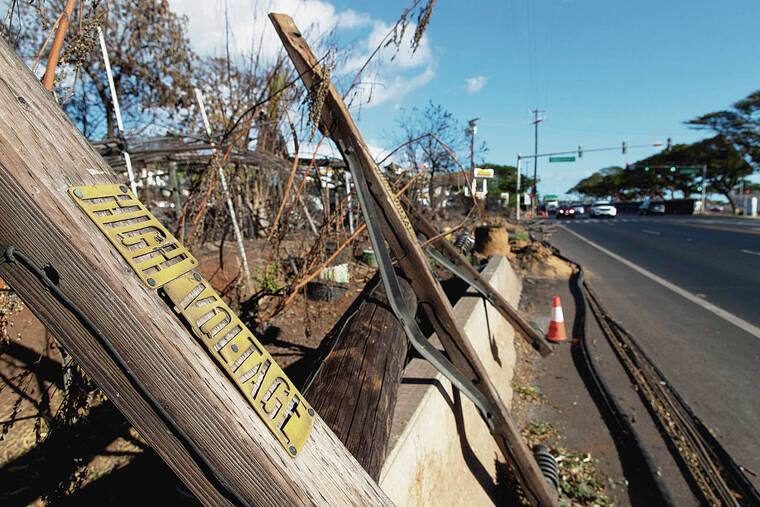One of Hawaiian Electric’s largest customers — Maui County — on Thursday sued the local utility serving 95% of the state, alleging that the company is liable for damage from three wildfires.
The county claims that negligent Hawaiian Electric operations caused the Aug. 8 fires in Lahaina, Kula and Olinda and that the power company should pay for damage to public property, lost revenue and expenses for emergency response and recovery.
“Maui County stands alongside the people and communities of Lahaina and Kula to recover public resource damages and rebuild
after these devastating utility-
caused fires,” the county said in
a statement.
Losses to the county for which damages are being sought through the lawsuit filed in state Circuit Court on Maui include firefighting costs, overtime for other county employees, a decline in property taxes and other revenue, environmental damage and destroyed public property from cultural sites to parks to stop signs.
Hawaiian Electric did not respond to allegations in the complaint, hewing to a policy of not commenting on pending litigation, but did issue a statement in response to the county’s action.
“Our primary focus in the wake of this unimaginable tragedy has been to do everything we can to support not just the people of Maui, but also Maui County,” the company statement said. “We are very disappointed that Maui County chose this litigious path while the investigation is still
unfolding.”
A cause of the Lahaina fire and two others in Upcountry Maui have not yet been determined.
Maui County’s lawsuit was the 11th legal complaint filed in state court as of yesterday afternoon against Hawaiian Electric seeking damages related to the fires. The other cases were all filed by individuals or groups of individuals who suffered losses of property
or life, except for one case that claims fire survivors will suffer future health problems stemming from toxic substances that were released from burning materials and polluted the air, soil and water.
One other lawsuit was filed Thursday in federal court in California on behalf of shareholders in the utility company’s parent, Hawaiian Electric Industries Inc., who acquired the company’s stock
between Feb. 28, 2019, and Aug. 16, 2023, according to the stockholder rights law firm Bragar Eagel &Squire PC, based in New York.
Shares of HEI have plummeted 68% from $37.36 on Aug. 7, a day before the
Lahaina fire, and closed at $11.86 Thursday.
The company also has had its credit rating slashed, and stock analysts have said it’s possible that Hawaiian Electric may be forced to seek bankruptcy protection to survive. If that happens, the company is expected to keep operating, as it provides an essential public
service providing electricity across every county except Kauai. How all the fire-
related trouble plays out
for the company, along with impacts on ratepayers, is uncertain.
The county’s effort to alert people in Lahaina as the very fast-moving flames overran firefighters has been faulted by survivors and others, while the Maui Fire Department was stretched thin by the multiple fires and in some cases ran short of water due to infrastructure failures from the fire.
The Lahaina fire, which burned 2,170 acres, killed at least 115 people, destroyed about 2,200 buildings and damaged another roughly 500 structures in what represents the deadliest wildfire in the U.S. in over a century. Nearly the entire town, much of it historic, was reduced to ruins Aug. 8, and damage has been estimated at $5.6 billion.
A second fire on Aug. 8 burned over 200 acres in the Upcountry Maui community of Kula and destroyed at least 15 structures.
The third fire, which began the night of Aug. 7, burned over 1,000 acres in Olinda near Kula and destroyed multiple structures, according to the county.
As with all the Maui fire litigation against Hawaiian Electric, including affiliates, Maui County contends that the company acted negligently by not cutting
electricity to the grid in
response to a National Weather Service forecast for wind gusts up to 60 miles per hour and a “Red Flag” warning of high fire risk due to dry brush conditions, and that fallen live power lines ignited the disaster.
“Had (Hawaiian Electric) heeded the NWS warnings and de-energized their
powerlines during the predicted high-wind gusts, this
destruction could have been avoided,” the county’s complaint said.
The county’s lawsuit also alleges that the utility, which operates as Maui Electric Co. on the Valley Isle, failed to sufficiently maintain its equipment.
“When you do both of those things together, then you have a situation where you start a fire, and we believe that’s below the standard of care,” said John Fiske, an attorney with the law firm Baron &Budd PC in San Diego helping represent the county in the case.
County Department of the Corporation Counsel attorneys are also part of the litigation team, along with attorneys from Honolulu-based law firm Cronin Fried Sekiya Kekina &Fairbanks and a second San
Diego-based firm, Diab Chambers LLP.
The two San Diego firms claim to have represented public entities 95 times to recover civil damages in wildfire cases.
Those cases, Fiske said, include a $270 million recovery for the local government of Paradise, Calif., related to the Camp fire in 2018, and $252 million recovered for Butte County, Calif., in connection with the Butte fire in 2015.
The Butte fire burned over 70,000 acres and destroyed over 900 homes and other structures, while the Camp fire killed 85 people and destroyed 19,000 properties, including homes.
Fiske said it’s too early to estimate the value of Maui County losses due to the three fires.
“There can be large numbers when you see destruction of this nature,” he said.




